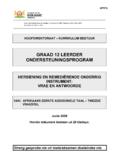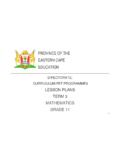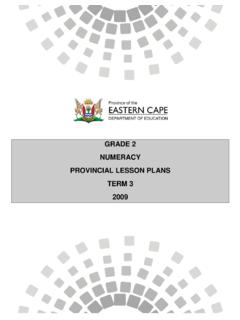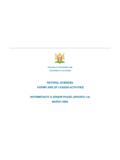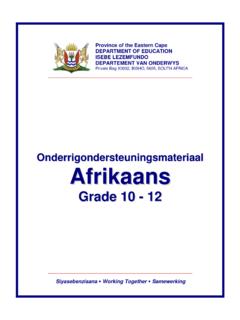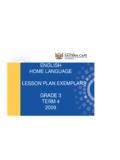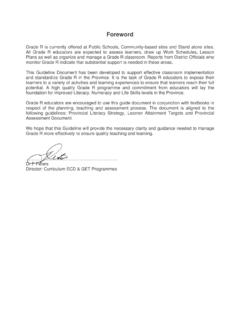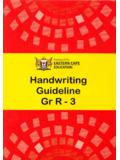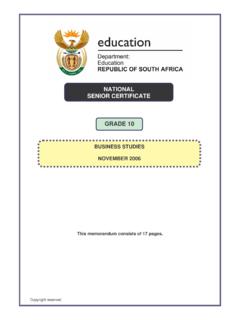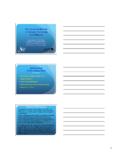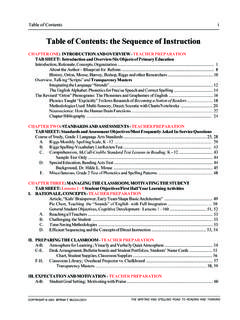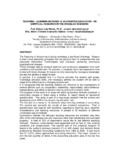Transcription of LESSON PLANS FOR SOCIAL SCIENCES. FOREWORD.
1 LESSON PLANS FOR SOCIAL sciences . foreword . In order to assist teachers in schools, so that they are more articulate and spot on in preparing lessons that are NCS compliant ,the Curriculum Chief Directorate together with the Districts have embarked on a programme to prepare lessons and assessment tasks that are based on the work schedule. These cover the period until the end of the second term. The focus is on Intermediate and Senior Phase. It is envisaged that this effort would be of assistance especially to those teachers who either still have challenges with preparation of LESSON PLANS , or are still uncertain as how to prepare LESSON PLANS that are rooted in Learning Outcomes and assessment Standards. To facilitate understanding and implementation of these LESSON PLANS , it is strongly advised that Subject Advisors in their respective districts must mediate these.
2 Since these LESSON PLANS are not cast on stone , teachers are therefore urged to adapt them so that they make sense and also make them as user friendly as possible in order to answer to learning and teaching environments that vary from place to place and from time to time. As much as possible, great care has been taken that these LESSON PLANS and assessment tasks cover both History and Geography almost equally, in all affected grades. Therefore , teachers should always try however hard, to strike this balance when teaching. We further urge teachers to always refer to the National Curriculum Statement, Training Manuals, Teacher s Resource Books, and any other Learner Teacher Support Material when preparing lessons. Also , teachers should always use a variety of textbooks and even go that extra mile of browsing through the Internet whenever possible in order to access up to date information.
3 If we can try all these methods consistently, we can without doubt produce lessons of good standard. 1 GRADE 4 LESSON PLANS TERM 2 LEARNING AREA : SOCIAL SCIENCES9(HISTORY) GRADE : 4 DURATION : 4 Hours CONTENT : History of transport and travel overtime KEY QUESTIONS : What forms of transport were used in the olden days? What forms of transport are used nowadays? Selected LOs and ASs Integration Teaching and Learning Activities Details of assessment Resources Barriers to learning LO 1 Historical enquiry AS 1:Records and organsises information from a variety of sources( oral, written and visual sources, including maps, graphs and tables, objects, buildings, monuments, museums)[works with sources] AS 2:Ues information from sources to answer questions about people, events, objects and places in the past LO1 Geo AS 1 AS 6 LO 3 Lang AS 3 Activity 1 The teacher together with learners brainstorming the term transport What is transport used for?
4 Learners discuss how they got to school that day. Activity 2 : Forms of transport The teacher introduces to learners 3 forms of transport, namely land, air and water transport The teacher brings a collage showing well illustrated forms of transport Learners are given case studies (extracts) which have land, air and water form of transport. The teacher helps learners to read Forms: Written class works Home works Research Case Study Method Teacher Peer Tool Marking memo Marking rubric (for research) Flip charts Textbooks 2 AS 3:Communicates knowledge and understanding in a variety of ways, including discussion, writing a paragraph, constructing a book, collage, poster, artwork, drama, dance and music [communicates the answer] and understand the case study. Learners identify hardships, difficulties and dangers around each form of transport Activity 3 : Advantages of earliest forms of transport teacher brings a flipchart with a wheel showing forms of transport dating from 200 years backwards.
5 Learners identify forms of transport in the wheel (chart). The teacher explains the uses of forms of earliest transport shown in the chart. In Classwork, learners list the advantages of earliest transport Activity 4 : Disadvantages of earliest forms of transport The teacher brings a chart showing types of earliest transport and the hours they travelled per day (which is 24 Hours)With the assistance of the teacher, learners orally discuss the disadvantages of using earliest forms of transport. Activity : 5 : Latest forms of transport Learners list modern forms of transport used when travelling With the assistance of the teacher, learners discuss the advantages of latest forms of transport Activity 6: Uses of transport The teacher groups learners and gives each group two forms of modern transport, learners identify the uses of those forms of transport 3 SKILLS Research skills Discussion Communication Participative listening KNOWLEDGE Forms of transport How to avoid accidents VALUES AND ATTITUDES Patience Tolerance Expanded opportunities Reflections 4 TERM 2 LEARNING AREA : SOCIAL sciences (HISTORY) GRADE : 4 DURATION : 7 Hours CONTENT : History of transport : KEY QUESTIONS : How to conduct Research Project?
6 Selected LOs and ASs Integration Teaching and Learning Activities Details of assessment Resources Barriers to learning LO 1 Historical enquiry AS 1:Records and organsises information from a variety of sources( oral, written and visual sources, including maps, graphs and tables, objects, buildings, monuments, museums)[works with sources] AS 2:Ues information from sources to answer questions about people, events, objects and places in the past LO1 Geo AS 1 AS 6 LO 3 Lang AS 3 Activity 1: Strategies of conducting a research project The teacher equips the learners on how to conduct a research. The following aspects are highlighted: Identification of a topic question Identification of resources Formulation and filling in of questionnaire Identification of resource persons Approaching the interviewees How to conduct themselves during the interview How to take notes, write summary Activity 2 Issuing of consent forms.
7 The teacher explains Forms Research Case Study Method Teacher Peer Tool Marking memo Marking rubric (for research Older people Photocopied extracts Consent forms 5 AS 3:Communicates knowledge and understanding in a variety of ways, including discussion, writing a paragraph, constructing a book, collage, poster, artwork, drama, dance and music [communicates the answer] aspects that appear in the consent forms. Learners are given a chance to ask questions for clarity purposes. Activity 3: Research Research about causes of road accidents and how they can be reduced. They are encouraged to get information from the print media and people around them(interviews) The teacher together with learners, design a questionnaire addressing research about causes of road accidents and how to reduce them Activity 3 Learners conduct individual research through interviews and reading of print media Research topic : Causes of road accidents and how they can be reduced.)
8 Activity 4 Learners present their research to the teacher , later they discuss their research experience and findings SKILLS Research skills Discussion Communication Participative listening KNOWLEDGE Forms of transport How to avoid accidents VALUES AND ATTITUDES Patience Tolerance Expanded opportunities Reflections 6 TERM 2 LEARNING AREA : SOCIAL SCIENCES9(Geography) GRADE : 4 DURATION : 7 Hours CONTENT : Resources and services within a settlement KEY QUESTIONS : What is a resource? What are renewable and non renewable resources? What are services? Selected LOs and ASs Integration Teaching and Learning Activities Details of assessment Resources Barriers to learning LO 3 Geo AS1:Identifies issues associated with resources and services in a particular context[identify the issue] AS2:Indentifies the factors that influence why some people have better access to resources compared to others in a particular context [factors affecting the issue] AS3: Suggests ways to LO 1 Hist AS1 3 Activity 1 The term resource is explained by the teacher.
9 With the assistance of the teacher, learners brainstorm and come up with examples of renewable, non renewable and natural resources Activity 2 The teacher explains importance of land as a resource. The teacher brings a collage/poster showing how human beings and animals suffer due to negative use of land. In groups, learners discuss factorsI(issues) that contribute to abuse of resources Activity 3 The teacher brings to class 2 pictures showing a rural settlement and urban settlement. Forms Classwork Test Method Teacher Tool Question Paper Memo Newspaper cuttings Textbooks Photocopied case studies Worksheets 7 improve access to resources in a particular context [makes choices] Learners must compare the 2 pictures identify similarities and differences. Looking at the pictures the teacher identifies factors that influence why people have better access to resources and services than others giving reasons like: Colonial rule apartheid system which led to h unger diseases, illiteracy unemployment, lack of health care The teacher gives learners 2 case studies.
10 The first story is based on a person staying in a rural area and the second one is based on a person staying in an urban area .Once the learners have read them they must identify services available in each area looking at the table below. Service Rural Areas Case study Urban Areas Case study Sewerage No Yes Rubbish removal Telephone Electricity Public transport Public library Medical service/Hospital/Cl 8 inic School Activity 4 The teacher shows learners 2 pictures, one with women carrying buckets of water on their heads, at the background there are round mud houses. The second one show people washing cars with water from the tap and at the background there is there is a big house with electricity. The teacher, together with learners explains the difficulties people encounter in rural areas and how these difficulties around access to resources can be improved.
